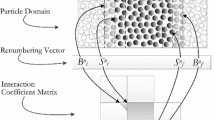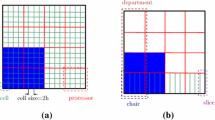Abstract
In this work, we propose a highly scalable parallel double binned ghost particle (DBGP) algorithm for direct-forcing immersed boundary spectral element method for multiphase flow simulations. In particular, the DBGP algorithm is designed to obtain fully distributed data storage and scalable data transfer across hundreds of thousands of processors. The proposed algorithm uses a queen and worker data structure for fully resolved particles to demarcate particle-level and marker-level quantities and communication. In the DBGP algorithm, each particle’s centroid is represented by a queen marker and the particle surface is covered with a uniform distribution of surface worker markers. The queen marker contains information on the translational and rotational motion of a particle and integrates the force and torque computed at all the worker markers, while the worker marker implements the fluid–particle interaction. Ghost queen and ghost worker markers are generated for each real queen and real worker marker during computation for particle-level and marker-level communications, respectively. A double Cartesian binning process is introduced that divides the physical domain into a coarse queen-bin and a fine worker-bin structure in three dimensions. The queen-bin and worker-bin sizes are determined by their zone of influence at the particle-level and marker-level communication, respectively. Bin-to-rank maps that relate each queen-bin and worker-bin to all the MPI ranks that they interact with are created. By using the queen/worker marker representation and two-layer bin-to-rank maps, data communication across very large number of MPI ranks is efficiently carried out. A scaling analysis has been conducted, showing excellent performance of the DBGP algorithm for up to 16,384 MPI ranks in both weak and strong scaling studies. The proposed method has been demonstrated to accurately predict sedimentation of particle clouds. The simulated correlation between the mean settling velocity and volume fraction is in good agreement with empirical correlations from previous studies.














Similar content being viewed by others
References
Akiki G, Balachandar S (2016) Immersed boundary method with non-uniform distribution of Lagrangian markers for a non-uniform Eulerian mesh. J Comput Phys 307:34–59
Akiki G, Moore W, Balachandar S (2017) Pairwise-interaction extended point-particle model for particle-laden flows. J Comput Phys 351:329–357
Bagchi P, Balachandar S (2002) Shear versus vortex-induced lift force on a rigid sphere at moderate Re. J Fluid Mech 473:379–388
Balachandar S, Eaton JK (2010) Turbulent dispersed multiphase flow. Annu Rev Fluid Mech 42:111–133
Berrut JP, Trefethen LN (2004) Barycentric Lagrange interpolation. SIAM Rev 46(3):501–517
Breugem WP (2012) A second-order accurate immersed boundary method for fully resolved simulations of particle-laden flows. J Comput Phys 231(13):4469–4498
Capecelatro J, Desjardins O (2013) An Euler–Lagrange strategy for simulating particle-laden flows. J Comput Phys 238:1–31
CEED team (2020) GSLIB Sparse communication library. https://ceed.exascaleproject.org/gslib/. Accessed 25 May 2020
Cundall PA, Strack OD (1979) A discrete numerical model for granular assemblies. Geotechnique 29(1):47–65
Deville MO, Fischer PF, Mund EH (2002) High-order methods for incompressible fluid flow, vol 9. Cambridge University Press, Cambridge
Fischer P, Kruse J, Mullen J, Tufo H, Lottes J, Kerkemeier S (2008) Nek5000: Open source spectral element CFD solver. Argonne National Laboratory, Mathematics and Computer Science Division, Argonne, see https://nek5000.mcs.anl.gov/. Accessed 25 May 2020
Fornberg B (1980) A numerical study of steady viscous flow past a circular cylinder. J Fluid Mech 98(4):819–855
Glowinski R, Pan TW, Hesla TI, Joseph DD (1999) A distributed Lagrange multiplier/fictitious domain method for particulate flows. Int J Multiph Flow 25(5):755–794
Gottlieb S, Shu CW (1998) Total variation diminishing Runge–Kutta schemes. Math Comput Am Math Soc 67(221):73–85
He L, Tafti DK, Nagendra K (2017) Evaluation of drag correlations using particle resolved simulations of spheres and ellipsoids in assembly. Powder Technol 313:332–343
Johnson T, Patel V (1999) Flow past a sphere up to a Reynolds number of 300. J Fluid Mech 378:19–70
Kempe T, Fröhlich J (2012) An improved immersed boundary method with direct forcing for the simulation of particle laden flows. J Comput Phys 231(9):3663–3684
Mazzuoli M, Blondeaux P, Vittori G, Uhlmann M, Simeonov J, Calantoni J (2020) Interface-resolved direct numerical simulations of sediment transport in a turbulent oscillatory boundary layer. J Fluid Mech 885:A28
Mohd-Yusof J (1997) Combined immersed-boundary/b-spline methods for simulations of flow in complex geometries. Annual Research Briefs. NASA Ames Research Center-Stanford University Center of Turbulence Research: Stanford pp 317–327
Mordant N, Pinton JF (2000) Velocity measurement of a settling sphere. Eur Phys J B Condens Matter Complex Syst 18(2):343–352
Nagendra K, Tafti DK, Viswanath K (2014) A new approach for conjugate heat transfer problems using immersed boundary method for curvilinear grid based solvers. J Comput Phys 267:225–246
Navarro HA, de Souza Braun MP (2013) Determination of the normal spring stiffness coefficient in the linear spring-dashpot contact model of discrete element method. Powder Technol 246:707–722
Offermans N, Marin O, Schanen M, Gong J, Fischer P, Schlatter P, Obabko A, Peplinski A, Hutchinson M, Merzari E (2016) On the strong scaling of the spectral element solver nek5000 on petascale systems. In: Proceedings of the Exascale Applications and Software Conference 2016. ACM, p 5
Patera AT (1984) A spectral element method for fluid dynamics: laminar flow in a channel expansion. J Comput Phys 54(3):468–488
Peskin CS (2002) The immersed boundary method. Acta Numer 11:479–517
Pinelli A, Naqavi I, Piomelli U, Favier J (2010) Immersed-boundary methods for general finite-difference and finite-volume Navier–Stokes solvers. J Comput Phys 229(24):9073–9091
Richardson J, Zaki W (1954) This week’s citation classic. Trans Inst Chem Eng 32:35–53
Roma AM, Peskin CS, Berger MJ (1999) An adaptive version of the immersed boundary method. J Comput Phys 153(2):509–534
Saff EB, Kuijlaars AB (1997) Distributing many points on a sphere. Math Intell 19(1):5–11
Schiller L, Naumann A (1933) Über die grundlegenden berechnungen bei der schwerkraftaufbereitung. Z Ver Dtsch Ing 77:318–320
Sharma N, Patankar NA (2005) A fast computation technique for the direct numerical simulation of rigid particulate flows. J Comput Phys 205(2):439–457
Taneda S (1956) Experimental investigation of the wake behind a sphere at low Reynolds numbers. J Phys Soc Jpn 11(10):1104–1108
Tenneti S, Garg R, Subramaniam S (2011) Drag law for monodisperse gas–solid systems using particle-resolved direct numerical simulation of flow past fixed assemblies of spheres. Int J Multiph Flow 37(9):1072–1092
Tenneti S, Subramaniam S (2014) Particle-resolved direct numerical simulation for gas-solid flow model development. Annu Rev Fluid Mech 46:199–230
Tufo HM, Fischer PF (2001) Fast parallel direct solvers for coarse grid problems. J Parallel Distrib Comput 61(2):151–177
Uhlmann M (2004) Simulation of particulate flows on multi-processor machines with distributed memory, Technical report. Centro de Investigaciones Energeticas Medioambientales y Tecnologicas (CIEMAT)
Uhlmann M (2005) An immersed boundary method with direct forcing for the simulation of particulate flows. J Comput Phys 209(2):448–476
van der Hoef MA, Ye M, van Sint Annaland M, Andrews A, Sundaresan S, Kuipers J (2006) Multiscale modeling of gas-fluidized beds. Adv Chem Eng 31:65–149
Valero-Lara P (2014) Accelerating solid–fluid interaction based on the immersed boundary method on multicore and GPU architectures. J Supercomput 70(2):799–815
Wang S, He G, Zhang X (2013) Parallel computing strategy for a flow solver based on immersed boundary method and discrete stream-function formulation. Comput Fluids 88:210–224
Wang Z, Fan J, Luo K (2008) Parallel computing strategy for the simulation of particulate flows with immersed boundary method. Sci China Ser E Technol Sci 51(8):1169–1176
Yin X, Koch DL (2007) Hindered settling velocity and microstructure in suspensions of solid spheres with moderate reynolds numbers. Phys Fluids 19(9):093302
Yu Z, Lin Z, Shao X, Wang LP (2016) A parallel fictitious domain method for the interface-resolved simulation of particle-laden flows and its application to the turbulent channel flow. Eng Appl Comput Fluid Mech 10(1):160–170
Zwick D, Balachandar S (2019) A scalable Euler–Lagrange approach for multiphase flow simulation on spectral elements. Int J High Perform Comput Appl. https://doi.org/10.1177/1094342019867756
Acknowledgements
This work was partially supported by the US Department of Energy, National Nuclear Security Administration, Advanced Simulation and Computing Program, as a Cooperative Agreement under the Predictive Science Academic Alliance Program, under Contract No. DENA0002378. YY would like to thank David Zwick and Jorge Salinas for their insightful discussion and help on the code development.
Author information
Authors and Affiliations
Corresponding author
Additional information
Publisher's Note
Springer Nature remains neutral with regard to jurisdictional claims in published maps and institutional affiliations.
Rights and permissions
About this article
Cite this article
Yang, Y., Balachandar, S. A scalable parallel algorithm for direct-forcing immersed boundary method for multiphase flow simulation on spectral elements. J Supercomput 77, 2897–2927 (2021). https://doi.org/10.1007/s11227-020-03371-2
Published:
Issue Date:
DOI: https://doi.org/10.1007/s11227-020-03371-2




